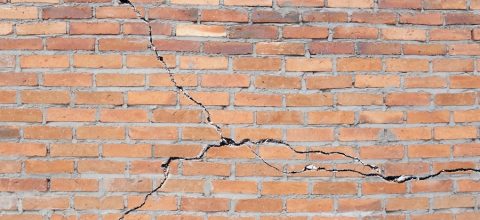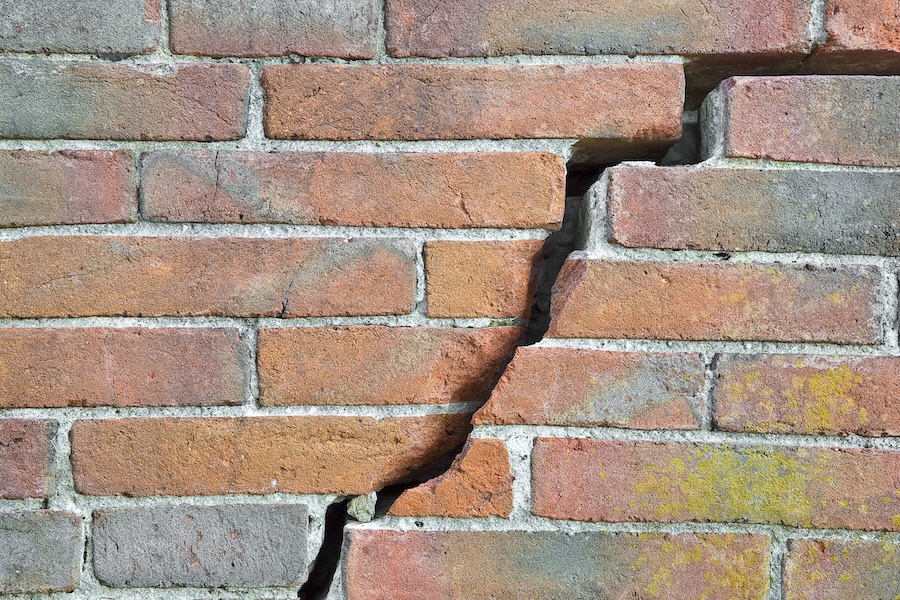Quick Answer: Most brick cracks in your brick house need professional evaluation. You should be immediately concerned about horizontal crack patterns, stair step cracks wider than 1/8 inch, or any vertical crack that’s growing. Small crack or hairline crack patterns may simply be cosmetic cracks from thermal expansion or seasonal changes. However, any crack wider than 1/8 inch or showing recent growth indicates a potential foundation issue that requires attention.
The reality is that brick cracks are never completely normal. They often signal underlying foundation problems that need professional assessment. While some minor cracks result from weather conditions and natural building movement, others point to serious structural issues that can threaten your home’s stability.
Understanding the difference between harmless cosmetic cracks and dangerous structural warning signs helps you make informed decisions about your home’s safety. Let’s explore what different types of cracks mean and when you should take action.
Understanding Different Types of Brick Cracks and What They Mean
Not all cracks are created equal. The pattern, location, and size of cracks in your brick wall tell important stories about what’s happening beneath the surface.
Vertical Cracks: Common but Worth Monitoring
Vertical crack patterns typically run straight up and down along your brick wall. These often develop from thermal expansion as bricks absorb and release moisture throughout seasonal changes. When temperatures fluctuate, bricks expand and contract, sometimes creating small crack lines.
Most vertical crack patterns start as minor cracks that don’t threaten your home’s structure. However, they deserve attention when they:
- Grow wider than 1/8 inch
- Show recent expansion or lengthening
- Appear alongside other foundation issues
Even hairline crack patterns that seem harmless can indicate foundation settling or foundation movement if they continue growing over time.
Horizontal Brick Cracks: Red Flags for Foundation Problems
Horizontal crack patterns represent the most serious type of brick wall damage. These cracks typically indicate significant foundation problems, particularly from hydrostatic pressure or major foundation damage.
When soil moisture builds up around your concrete foundation without proper drainage, it creates pressure against foundation walls. This pressure can cause horizontal brick cracks that often accompany wall bowing or inward movement.
Horizontal brick patterns differ from horizontal brick cracks in important ways. Natural brick patterns are intentional design elements, while horizontal brick cracks signal structural damage that needs immediate foundation repair attention.
Stair Step Cracks: Classic Signs of Foundation Settlement
Stair step cracks follow the mortar joint lines in a distinctive zigzag pattern that looks like stairs. These cracks almost always indicate differential settlement, where your foundation settles unevenly into the ground.
Differential settlement creates stress throughout your foundation and the brick veneer above it. As one section of your foundation moves differently than another, the brick wall reflects this movement through stair step crack patterns.
Diagonal Crack Patterns: Understanding Structural Movement
Diagonal crack lines can indicate various types of foundation movement or structural damage. In an older home, these might develop as the structure naturally shifts over time. However, diagonal crack patterns combined with other symptoms often point to ongoing foundation problems.
The key difference lies in how brick veneer cracks versus structural brick damage appears. Brick veneer cracks typically affect only the outer layer, while structural damage impacts the load-bearing elements of your wall.
Root Causes Behind Brick Cracks
Understanding why cracks develop helps you identify potential solutions and prevent further damage to your property.
Foundation Settlement and Structural Issues
Foundation settlement occurs when your concrete foundation sinks unevenly into the soil. Several factors contribute to this foundation problem:
- Soil conditions: Expansive clay soils expand when wet and shrink when dry, creating unstable conditions for your foundation. Poor soil drainage compounds these issues by allowing water to accumulate around foundation walls.
- Foundation settling versus foundation settlement: Foundation settling refers to normal, minor movement as a new structure adjusts. Foundation settlement indicates problematic movement that creates structural issues requiring professional intervention.
A structural engineer can assess whether foundation movement falls within normal ranges or indicates serious foundation damage. These professionals understand how crawl space conditions, soil types, and construction methods interact to create various foundation problems.
Environmental Factors: Soil, Water, and Weather Impact
Your home’s environment plays a major role in brick wall stability and foundation health.
- Water and drainage: Poor drainage allows water to accumulate near your foundation, creating hydrostatic pressure that can crack foundation walls and damage brick veneer above. This moisture also affects crawl space conditions, potentially causing additional structural problems.
- Tree roots: Large trees growing too close to your foundation can cause several issues. Tree roots absorb moisture from soil, causing uneven drying and foundation movement. Additionally, growing roots can physically push against foundation walls, creating pressure that leads to cracks.
- Weather conditions and seasonal changes: Temperature fluctuations cause thermal expansion in brick and mortar materials. While this natural process usually creates only minor cracks, repeated expansion and contraction can worsen existing foundation issues.
Age-Related Factors in Brick Homes
Older home construction often used different techniques and materials than modern building standards require. Brick homes built decades ago might have:
- Different mortar mix formulations that age differently
- Fewer or inadequate expansion joints
- Crawl space designs that don’t manage moisture effectively
- Foundation systems less resistant to soil movement
These factors don’t automatically create problems, but they can make an older home more susceptible to foundation issues over time.
Construction and Design Considerations
Sometimes brick cracks result from original construction issues rather than later foundation problems:
- Mortar joint quality: Poor mortar mix or improper installation creates weak points where cracks commonly develop. Quality mortar joints should last decades without significant deterioration.
- Brick veneer installation: Improperly installed brick veneer may not accommodate natural building movement, leading to premature cracking. Adequate expansion joints and proper anchoring systems help prevent these issues.
- Exterior wall design: The connection between your brick veneer and the underlying structure affects long-term performance. Poor design or installation can create stress points that develop into cracks over time.
Warning Signs That Require Immediate Professional Attention
Certain crack characteristics indicate serious structural problems that need prompt evaluation and potential foundation repair.
Critical Crack Characteristics That Signal Danger
Watch for these warning signs that indicate potential structural issues:
- Large brick cracks wider than 1/8 inch: These typically indicate significant foundation movement or structural damage beyond normal settling.
- Small brick cracks that grow rapidly: Even initially minor cracks become concerning when they expand quickly over weeks or months.
- Horizontal brick cracks with wall bowing: This combination almost always indicates serious foundation problems requiring immediate attention.
- Multiple crack types appearing together: When you notice various wall crack patterns simultaneously, this suggests comprehensive structural issues.
Associated Structural Problems to Watch For
Brick cracks rarely occur in isolation. Look for these accompanying signs of foundation problems:
- Uneven floors: Floors that slope, sag, or feel bouncy often indicate foundation movement affecting your home’s structural frame.
- Door and window issues: Doors that won’t close properly or windows that stick suggest your home’s frame is shifting due to foundation problems.
- Additional wall crack patterns: Cracks appearing in interior walls, especially near corners or openings, often accompany exterior brick wall damage.
- Gaps between walls and ceilings: Visible separations indicate structural movement that typically corresponds with foundation issues.
When DIY Monitoring Isn’t Enough
While you can monitor small crack development yourself, certain situations require professional assessment:
- Rapid changes: Any crack showing noticeable growth within a few weeks needs immediate professional evaluation.
- Multiple symptoms: When brick cracks appear alongside other structural problems, the combination suggests complex foundation issues beyond simple monitoring.
- Safety concerns: Large brick cracks, horizontal brick cracks, or structural crack patterns that appear suddenly pose potential safety risks requiring expert evaluation.
A structural engineer can determine whether cracks indicate isolated brick veneer issues or broader structural damage requiring comprehensive foundation repair.
Professional Solutions and Why Expert Foundation Repair Matters
Different types of cracks require different repair methods, and proper diagnosis determines the most effective solution.
Modern Repair Methods for Different Crack Types
- Foundation settlement repairs: When differential settlement causes brick wall cracks, foundation repair typically involves underpinning systems. Professional contractors install push piers, helical piers, or slab piers to stabilize and potentially lift settling foundations.
- Hydrostatic pressure solutions: Horizontal brick cracks from water pressure often require drainage improvements combined with wall stabilization using carbon fiber systems or steel braces.
- Brick veneer repairs: Sometimes cracks affect only the brick veneer rather than indicating foundation problems. These repairs might involve repointing mortar joints, replacing damaged bricks, or installing proper expansion joints.
The Value of Professional Foundation Assessment
Professional evaluation provides several advantages over DIY assessment:
- Accurate diagnosis: Experienced professionals distinguish between cosmetic brick veneer cracks and serious structural damage
- Comprehensive solutions: Rather than addressing only visible symptoms, professionals identify and fix underlying foundation problems
- Prevention of further damage: Proper repairs prevent minor issues from developing into major structural problems
Long-term Solutions vs. Quick Fixes
Effective foundation repair addresses root causes rather than just visible symptoms. Quick fixes like sealing surface cracks without addressing underlying foundation movement often lead to recurring problems and additional expense.
When choosing foundation repair professionals in Hampton Roads, experience with local soil conditions and construction methods makes a significant difference in solution effectiveness. At AMC911 Crawl Space & Foundation Repair, our team brings over 30 years of experience solving foundation problems for local homeowners.
Our Class A contractor status and in-house engineering team ensure that every foundation repair project receives proper analysis and engineered solutions. We understand that a strong foundation truly does pave the way to better living, which is why we’re committed to providing lasting solutions that protect your home’s structural integrity and your family’s safety.
If you’ve noticed brick cracks in your home, don’t wait for the problem to worsen. Contact our team for a thorough evaluation and learn how professional foundation repair can restore your confidence in your home’s stability.


















